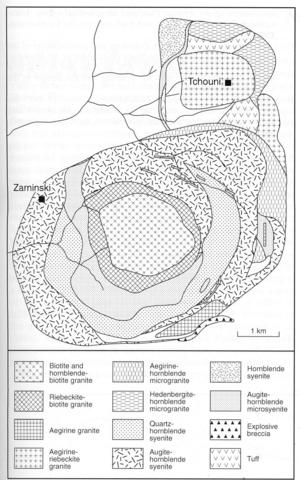stripes
The Tchouni and Zarniski complexes overlap, the latter cutting across units of the former. Zarniski is a well developed ring-complex of granites and syenites, while the smaller Tchouni complex contains similar rock types together with some tuffs. Within the 7x5 km Zarniski intrusion 11 units were mapped by Black (1963) the earliest of which is an explosive breccia. This was followed by augite-hornblende syenites and microsyenites, a fayalite-augite microsyenite, which forms thin arcuate sheets, and then a quartz-hornblende syenite. These rocks also contain biotite and accessory magnetite, ilmenite, zircon, allanite and calcite. There then followed a series of six granite and microgranite intrusions, all but the last two of which are peralkaline. In order of emplacement they are aegirine-amphibole microgranite, aegirine granite, aegirine microgranite, riebeckite-biotite granite, hornblende-biotite granite and biotite granite. The feldspar is perthite and accessories include fluorite, zircon, apatite and allanite with cassiterite being found in the biotite granite. The earliest rocks in the Tchouni centre are also fragmentary comprising a band of tuffs which again were followed by hornblende syenite and augite-hornblende microsyenite. These were followed by a hedenbergite-hornblende microgranite and finally an aegirine-riebeckite granite. Analyses of Zarniski rocks are given by Black (1963).
BLACK, R. 1963. Notes sur les complexes annulaires de Tchouni-Zarniski et de Gouré (Niger). Bulletin, Bureau de Recherche Géologie et Minière, 1: 31-45.KARCHE, J.-P. and VACHETTE, M. 1978. Age et migration de l'activité magmatique dans les complexes paléozoïques du Niger. Consequences. Bulletin de la Société Géologique de France, 20: 941-53.

